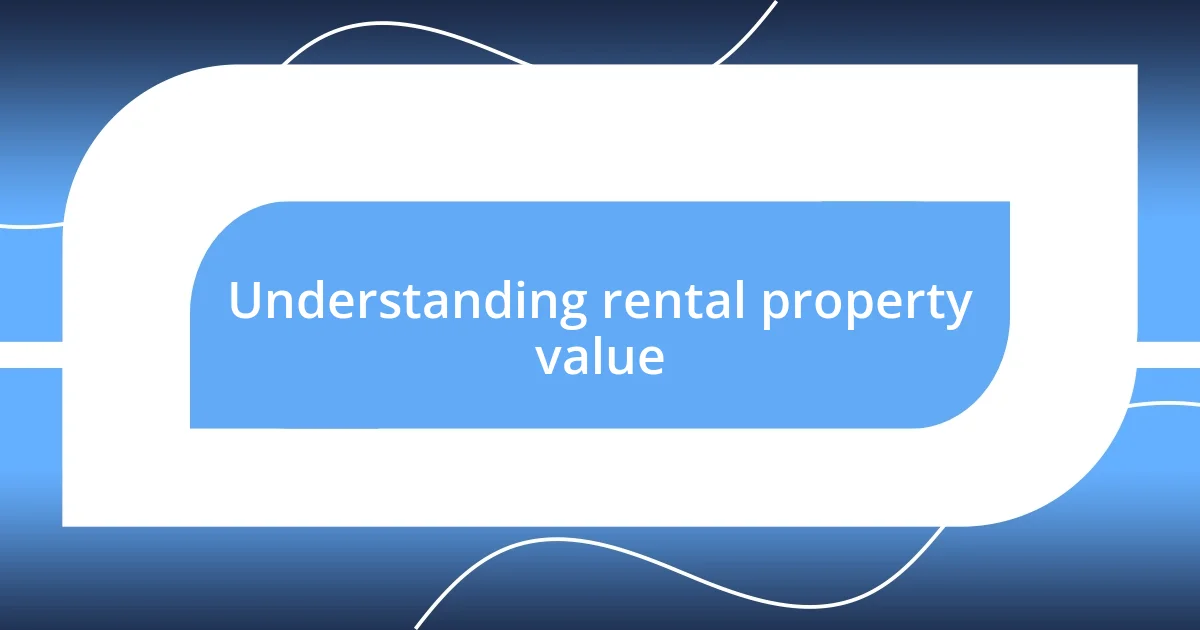Key takeaways:
- Understanding rental property value involves location, condition, and market demand, not just size or amenities.
- Regular maintenance is essential for tenant retention and property value, preventing small issues from escalating into costly repairs.
- Upgrading amenities and enhancing curb appeal significantly improve a property’s attractiveness and can foster a sense of community among tenants.

Understanding rental property value
Understanding the value of a rental property goes beyond simple numbers; it encompasses the location, condition, and market demand. I often find myself reflecting on a property I once managed in a burgeoning neighborhood. It was fascinating to see how much community developments, like parks and shops, could elevate its value almost overnight.
When I think about rental property value, I can’t help but ask myself: what truly makes a property desirable? In my experience, it’s not just about square footage or amenities. Factors like cleanliness, curb appeal, and the quality of nearby schools can significantly impact a tenant’s willingness to pay a premium. I’ve noticed that some of my most successful investments were in homes that, while modest, had that intangible charm that drew people in.
Another essential aspect is maintenance and timely upgrades. I remember a property where neglected landscaping almost deterred potential renters. Just a little effort in improving the exterior led to increased interest and higher rents. It’s a poignant reminder: investing in the appearance and functionality of your rental can directly translate to its value. Would you rather settle for a quick fix, or invest in long-term growth?

Importance of regular maintenance
Regular maintenance is crucial for preserving the value of a rental property. I remember a time when I decided to neglect minor repairs, thinking they wouldn’t affect the overall appeal. However, after a few months, I noticed potential tenants were hesitant to show interest. Little did I realize, what might seem trivial—like a leaky faucet or chipped paint—could create a perception of neglect, making the property less appealing.
In my experience, consistent upkeep not only prevents small issues from escalating but also enhances tenant satisfaction. Once, I implemented a quarterly maintenance schedule for one property, which included everything from HVAC checks to landscaping. The result was remarkable; tenants felt valued and appreciated, leading to renewed leases and even word-of-mouth referrals. It reinforced my belief that proactive maintenance pays off in tenant retention and property value.
Moreover, regular maintenance can significantly reduce long-term costs. One winter, I delayed inspecting the roof of a rental property and ended up facing a major leak that required extensive repairs. It was a costly lesson that taught me the importance of staying ahead of maintenance tasks. Investing in routine inspections can save both time and money, ultimately contributing to the overall value of the rental property.
| Benefit | Description |
|---|---|
| Increased Appeal | Regular maintenance keeps the property looking well-kept, attracting more tenants. |
| Tenant Satisfaction | Maintenance enhances tenant comfort and trust, leading to longer stays. |
| Cost Efficiency | Prevents small issues from becoming major repairs, saving money in the long run. |

Upgrading property amenities
Upgrading property amenities can dramatically enhance the allure of a rental property. I often reflect on a successful upgrade I made to one of my units: adding a modern kitchen with stainless steel appliances. The excitement among prospective tenants was palpable; it felt like I had opened the door to a new lifestyle for them. Investing in amenities not only attracts renters but can also inspire them to stay longer, as they appreciate the comfort and convenience provided.
Here are some key amenities that can elevate your property’s appeal:
- High-Efficiency Appliances: Energy-saving models can reduce utility bills, making your property more attractive.
- Smart Home Technology: Features like smart thermostats and security systems offer convenience and peace of mind.
- Outdoor Spaces: A well-maintained patio or garden can serve as a sanctuary for tenants, enhancing their living experience.
- Upgraded Bathrooms: A fresh, modern bathroom can create a spa-like atmosphere that tenants find irresistible.
- In-Unit Laundry Facilities: Convenience is vital; having a washer and dryer in the unit can be a deciding factor for many renters.
I vividly remember another property where I upgraded the common areas by adding a small gym and lounge space. I hoped it would amplify tenant engagement and community feeling. The change was inspiring; tenants began hosting their own get-togethers, creating a vibrant community atmosphere. It’s moments like these that highlight how thoughtful upgrades can foster connections and elevate the overall living experience.

Enhancing curb appeal effectively
Elevating curb appeal is often easier than one might think, and it truly sets the tone for how potential tenants perceive a rental property. I recall a time when I decided to repaint the front door a vibrant shade of blue, and that small change transformed the entire facade. Suddenly, the house seemed inviting and lively, catching the eye of passersby. It’s amazing how something as simple as a fresh coat of paint can breathe new life into a property.
Landscaping is another critical component of curb appeal that I’ve found to make a noticeable difference. For instance, I once invested in a low-maintenance flower bed filled with colorful perennial plants. Not only did it beautify the entrance, but it also created a warm and welcoming atmosphere, prompting many compliments from visitors. This experience solidified my belief that thoughtful landscaping can draw in interest and foster a sense of pride in the property.
Lighting plays a pivotal role, too. After installing stylish, energy-efficient outdoor fixtures, I noticed a remarkable change in how the property felt at night. The soft glow not only highlighted the architectural features but also made the space feel safe and inviting. Have you ever walked past a dark rental property? It can feel uninviting and unkempt. In contrast, the right lighting can transform the experience, showcasing the property’s best angles and encouraging potential renters to envision themselves living there.

Strategies for tenant retention
When it comes to tenant retention, open communication is crucial. I’ve found that being approachable and responsive to tenants’ concerns creates a sense of trust. For example, I once had a tenant who faced a plumbing issue. Instead of waiting for a maintenance request, I reached out proactively to ensure everything was okay. This small gesture made them feel valued and respected, which ultimately led to their decision to renew the lease instead of looking elsewhere.
Engaging tenants with community events can also foster a sense of belonging. I remember hosting a barbecue in the shared garden space of one of my buildings. The laughter and camaraderie that unfolded created bonds between tenants who had never spoken before. It was heartening to see how those interactions led to a tighter-knit community, which is often the reason tenants choose to stay. Have you ever experienced the joy of neighbors becoming friends? It can transform a living space into a home.
Furthermore, offering flexible lease options can cater to varying tenant needs, increasing their likelihood of staying. I once had a tenant whose work situation changed; they were uncertain about their future plans. By allowing them to switch to a month-to-month lease, they felt empowered and appreciated. That flexibility made all the difference; they ended up staying for another year! It’s interesting how adaptability can create loyalty—have you considered how accommodating your lease terms can impact tenant retention?

Financial planning for property improvements
Financial planning for property improvements requires a strategic approach that balances budget constraints with the potential for increased value. I remember when I decided to invest in energy-efficient appliances for one of my rental units. Initially, I hesitated at the cost, but the reduction in utility bills and the ability to market the unit as eco-friendly attracted tenants more quickly than I anticipated. Have you ever wondered how a small upfront investment can lead to long-term savings?
It’s essential to prioritize which improvements will yield the highest return on investment. I learned this the hard way when I poured funds into a high-end kitchen remodel that didn’t attract the kind of tenants I hoped for. Instead, I now focus on affordable upgrades like fresh paint and modern light fixtures that appeal broadly without breaking the bank. What have your experiences taught you about prioritizing improvements?
Setting aside a dedicated budget for maintenance is another key aspect that often gets overlooked. I now allocate a percentage of my monthly earnings specifically for maintenance and improvements, ensuring that funds are readily available when unexpected issues arise. I’ve discovered that this not only alleviates financial stress but also allows me to tackle projects sooner, ultimately enhancing the property’s value. How do you approach budgeting for ongoing property improvements?

Monitoring market trends regularly
Monitoring market trends is vital for maintaining rental property value. I often find myself scouring local real estate news and trends to keep my finger on the pulse of the market. For instance, I discovered that a nearby area was experiencing a surge in new businesses, which prompted me to adjust my rental rates. This knowledge not only helped me stay competitive but also affirmed the value of being informed.
In my experience, attending local open houses and networking events can provide firsthand insights into the market. I once attended an event where I learned about changes in zoning laws that would impact property development. This information was crucial; it allowed me to anticipate shifts in demand and make proactive decisions. Have you ever tried engaging with the community to gain insights? I’ve found that these interactions can be incredibly enlightening.
Ultimately, I believe that using market trend data to inform pricing strategies directly impacts property value. I recall a time when I hesitated to increase rent despite rising demand, afraid of losing my tenants. Once I finally adjusted the rates in line with the market, not only did I retain my current tenants, but I also attracted new ones looking for quality properties. It’s amazing how knowledge truly empowers us—how often do you evaluate your rental rates against market trends?














